UVA specific videos for:
Avoid A Painful Back!
According to the Bureau of Labor Statistics (BLS), back injuries account for one of every five injuries and illnesses in the workplace. Eighty percent of these injuries occur to the lower back and are associated with manual materials handling tasks. BLS further states that re-aggravation of a previous injury almost always results from a new incident which involves the employee (i.e. slip, twist, trip, extended reach). Lifting-related injuries include sprains, strains, neural related, neuromuscular related injuries and/or bone related injuries. These injuries can affect any part of the body, but the majority occur to the lower back.
The term best describing these ailments is idiopathic, which means without apparent cause. There is, however, a correlation between injury claims for low back pain and physical activities such as lifting, bending, twisting, pushing, pulling, etc. Cures remain unclear and back pain whether treated or untreated, can subside quickly or linger. Back pain can re-occur at any time. The bottom line is that YOU bear the responsibility for preventing back injury.
The following tips can help you maintain a healthy back.
If you are suffering from acute pain, seek medical attention first!!!
Get to Know Your Back!

Your back is composed of vertebrae, discs, nerves and muscles.
Vertebrae -- Vertebrae, (33 in number) are cylindrical bones which enclose the spinal cord, stacked vertically together, separated by discs to form the vertebral column or spine.
The spine's basic functions include...
When normally aligned, the spine forms 3 natural curves (cervical, thoracic, lumbar). Maintaining these natural curves keeps the spine in balance.
Discs -- The discs (articular pads composed of dense fibrocartilage) lie between each vertebrae. Each disc contains a jelly-like center surrounded by rings of tough fibrous tissue. These discs act as "spinal shock absorbers" during activities such as sitting, standing, walking, lifting, etc.
Nerves -- Nerves are a collection of fibers which carry electrical impulses throughout the body. The spinal cord stretches the length of the spine through the vertebral column. Smaller nerves branch out between each vertebrae to carry messages around the body.
Muscles, Ligaments, Tendons -- Muscles are tissues in the body which provide support and contract to produce movement. Ligaments are bands of fibrous tissue that connect bones or cartilage together - serving to support and strengthen joints. Tendons are fibrous cords of connective tissue which attach muscle to bone.
Recognize the 5 Leading Back Injury Risk Factors!

Check Your Working Posture!
"Try this... Place one hand cupped under your chin, with the other in back of your head at the base of the skull. Pick your head up (gently) and move it to the point at which it's aligned over your spinal column. Your head weighs a lot, doesn't it? Where do you usually carry your head as you work... pitched forward, like most of us? Think of the pressure this puts on those fragile spinal discs and how easily you can pull the whole spinal column out of alignment with incorrect carriage of the head. Having this awareness will help you correct as you go... adjusting the way in which your head is positioned over your spine during your hours at work." -- Working Well? by Terry McShane M.A.
Be Willing to Change Your Posture Habits!
Our bodies are designed to move, bend and flex - and our posture changes to fit the task. Static posture leads to discomfort and lower productivity. Be aware of your posture while working.
Maintain a neutral posture
When you assume a neutral posture, your body will find its natural balance.
Adjust your worksite to fit you before you begin the task.
NEUTRAL POSTURES INCLUDE...

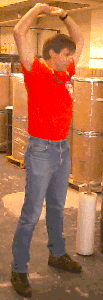
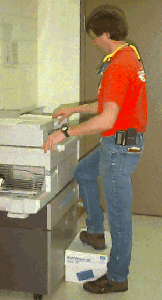
Handle Materials Carefully
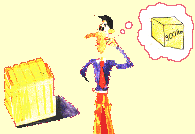
Did you know?
Therefore...?
Assess the situation and ask yourself these questions...
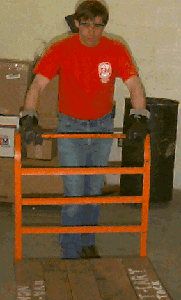
Is the load height located inside your "safe lifting zone"?

The safe lifting zone is between knees and shoulders. If the load is below knee level - bend your knees and lift with your legs. If the load is above your shoulders - use a stool or ladder. Better yet, rearrange the contents on the shelves so that heavier and more frequently needed items are placed on the mid-level shelves. If it is heavy - get help.
Must you twist or stretch to get it?
Adjust the load or your position before you lift.
Get help!
Do you need equipment (e.g. hand trucks, forklifts, dolly) to help move it?

Have you stretched your muscles or warmed up before lifting?
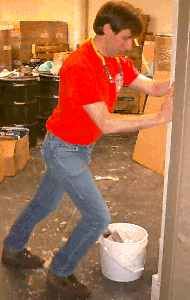
A few simple stretches before beginning to perform the task will warm up your muscles and increase your ease of movements. Stretch again to cool down and decrease potential stiffness after completing the task. Stretch periodically throughout the day.
Are you wearing slip resistant shoes?
Have you cleared a pathway before you move the item?
Instead of asking -- "Is this load within safe limits?" we should really be asking -- "Is the design of this lifting and handling task ergonomically satisfactory?" -- Ergonomics, Work and Health - Stephen Pheasant PhD, FErgS

When you lift...
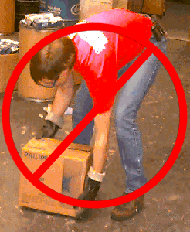
Conclusion
Working safely means using COMMON SENSE in the workplace, monitoring ergonomics trends in the workplace, staying physically fit and making injury prevention a top priority.
Remember your work day is one thrd of your total day. Plan your tasks carefully to avoid a painful back. Managing your back is your responsibility.